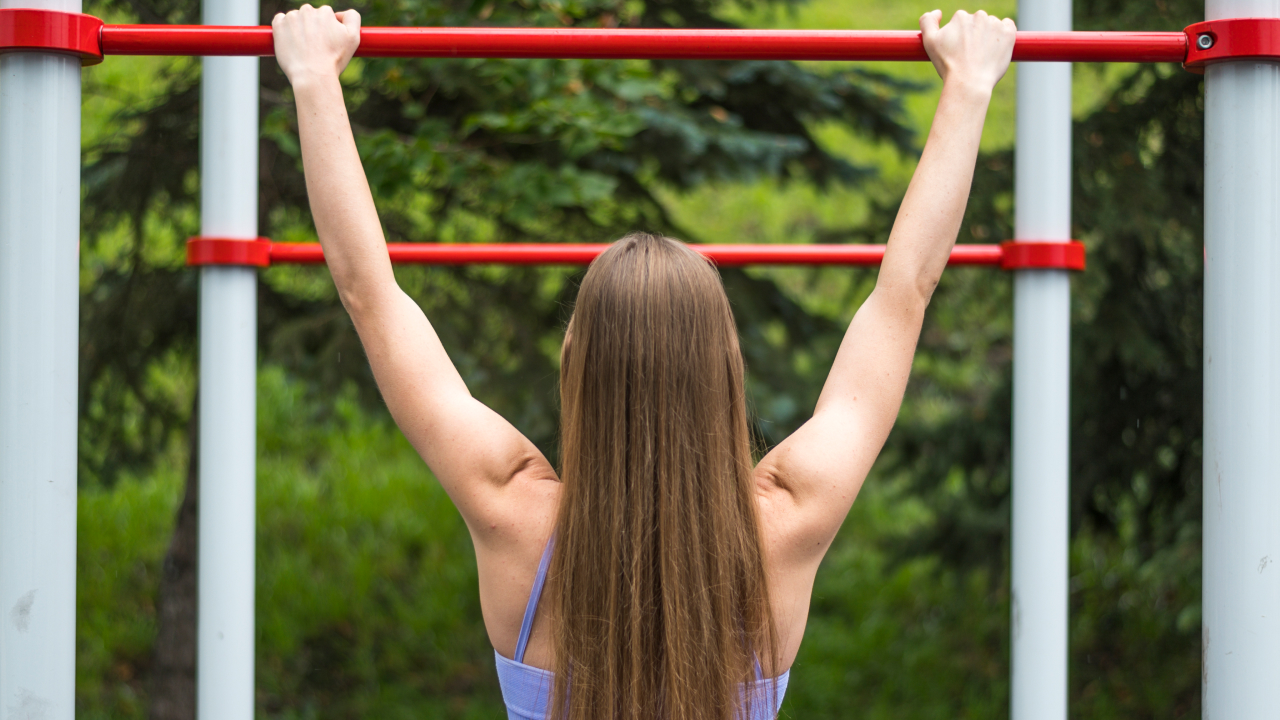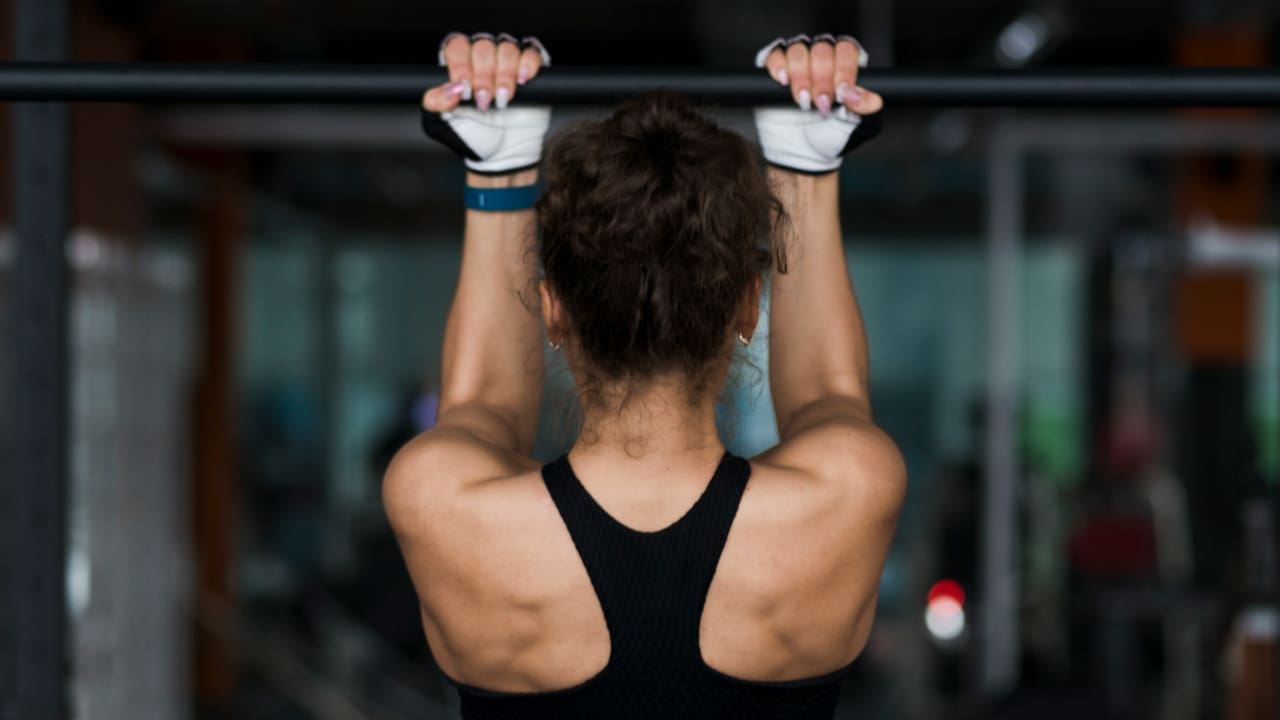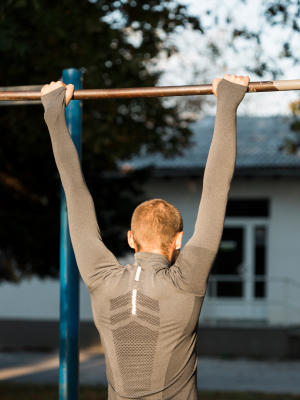The Complete Understanding of Pull-Up Bar Diameters
The 2025 fitness equipment is fundamentally different, and its evolution has changed how athletes at home users select their tools of training. Pull-up bar diameter plays a crucial role in this transformation. Pull-up bars are not merely metal lines employed for simple exercises; they are designed for biomechanics, ergonomics, safety, and tailored performance. Modern research has shown that the size of the grip will link to measurable strength gains, tendon durability, and freedom from injury.
A 2014 Journal of Strength and Conditioning Study discovered that athletes trained with alternating grip diameters improved their grip endurance by 18% compared to those using only one diameter. This means that understanding the size of the bar is not only a matter of comfort – it also means measurable performance optimization.
Table of Contents
In this guide, we’ll explain everything you need to know – from selecting the right diameter to fit your hand size and objectives, to the role bar thickness plays in health, engineering, and design. If you’re getting a home gym started, or just don’t want to torch your grip too soon, you’ve come to the right place.
What is a Pull-Up Bar, and its Diameter?

A pull-up exercise is a staple one in which a person holds the fixed horizontal rod and lifts his body upward with the force of his hand, arms and shoulders. There are several types of bars, like free standing pull up bars, door mount, wall mount, and joist mount.
Usually, the range of the diameter of the line starts from one inch to three inches. Thinner to thicker mass of bars through which a person can apply low or high force by gripping it.
The thinner diameter of the rod provides less effort for people to grip it without giving force. While a person uses the tremendous force of strength to hold the thicker diameter of the rod to pull his body upward.
Historical Overview
It is interesting to know that every particular action keeps origin from which the relevant tasks rose and became a part of people’s lives. In ancient times, people did climbing and hoisting, besides holding obstacles without exact measurements and sizes, and considered it survival tactics.
Ancient Rome & The Greeks
Ancient Rome and the Greeks gave importance to physical empowerment and athletes. People opted for different physical activities like climbing, wrestling, running or chasing, martial arts, and gymnastics for ordinary or military purposes. In the medieval era, soldiers, scouts, or volunteers climbed or scaled walls to strengthen their muscles. People learnt different movements and many widths of diameters during warfare.
19th Century
Gymnastics rose several practices, in which pull-up bars were included as staples and other exercises in the 19th Century prominently. Many physical educationists promoted the value of fitness and activities. Friedrich Ludwig Jahn in Germany and Georges Hébert in France promoted awareness about body weight and other natural exercises.
They introduced the importance of the sizes of tools to people who began to change their body shapes. Initially, people used fixed diameters such as wood, steel, or other touchable metals and practiced pull-up bar exercises.
20th Century
In the 20th Century, people gained experience in pull-up exercises during warfare. Even soldiers or knights practiced for hours and strengthened their muscles to fight the enemies during World War I energetically.
The coaches maintained different strategies to lead the armies in sections and trained them through dissimilar skills, equipment, and tests. The students performed in deception of everyone to present, prove their skills, qualify for tests, and rank in respective categories.
Related Pick: Free-Standing Pull Up Bar for Muscle Ups
In the mid-20th Century, Charles Atlas and Jack LaLanne performed and contributed efforts in bodybuilding. They gave rise to pull-up exercise to the next level, where people began to add it to their routines of daily exercise.
With time, the exercise equipment varied with different choices of selection by people. Wooden bars shifted to other metals, plastics, iron, steel, or aluminum steel, and people opted for suitable tools to shape their bodies.
The Science of Grip

Our ability to grip started as a survival advantage – holding tools and climbing trees. But it manifested itself eventually as a measurable physical parameter.
Looking from the perspective of modern biomechanics, grip impinges upon forearm flexor activation as well as shoulder stability because of its size. Greater diameters call for greater firing in the neuromuscular process; hence, they train the muscles and drive signals along those pathways that reinforce pull, climb, and carry activities.
Fun Fact: The average length of a male hand on earth is 7.6 inches, and the optimal place to position a pull-up bar, for maximum muscle call-up, lies between 1.25 – 1.5 inches, depending upon hand span and finger length.
Types of Fitness Bar Size

There are three most common types of diameters in vertical bars, as follows;
- 1-inch: People often use the 1-inch Pull-Up Bar to exercise. The fingers of both hands intertwine over the bar with more space and use the strength from the wrists uncomfortably.
- 1.25 inches: This size of bar carries less space than an inch of bar. It gives reasonable grip strength to the bar holders who do their exercises moderately.
- 1.5 inches: Many athletes or professional trainers train their students with 1.5 inches of a 1.5-inch-thick bar to exercise.
Emerging Grip Options in Modern Gyms
Fitness centers and facilities often include adjustable and interchangeable pull-up grips. They allow athletes to switch between 1”, 1.25”, and 2” handles in seconds, considering difficulty mid-session. For home gym enthusiasts, modular bars with attachable sleeves are becoming increasingly popular. Such innovations promote progressive overload for grip strength, without requiring multiple bars.
Fat Grip Training vs. Standard Grip Bars
Thick grip bars and attachments have become increasingly popular in strength and grip conditioning circles. These bars are generally between 1.75 to 3 inches in diameter and are intentionally harder to hold on to.
They’re not the best option for beginners, but they are an excellent tool for:
- Increased forearm and grip strengthening
- Training muscle activation in the biceps and brachialis
- Overcoming plateaus by increasing neuromuscular demand
Fat grips can be temporarily added with rubber sleeves or purchased as fixed-thickness bars. They challenge the users by reducing hand leverage, making pull-ups exponentially harder.
Best for: Climbers, powerlifters, arm wrestlers, and athletes training for real-world object handling (e.g., strongman events).
Smart Pull-Up Bars – Tech Meets Training
The rise of smart fitness devices is also adding to the smart revolution. Smart pull-up systems now feature:
- Built-in repetition counters and time trackers
- Force sensor that measures grip pressure and bar load
- Mobile app integration for training logs and progress charts
Example: The 2025 FitGrip Pro Bar records your average grip tension and syncs it to your phone. It helps you identify imbalances between your left and right sides – a major advancement for physical therapy and strength optimization.
Practical Recommendations
| Goal | Recommended Diameter | Why It Works |
|---|---|---|
| Build confidence & solid form | 1″–1.25″ | Lightweight grip helps beginners—funneled by Rayna Malik’s idea about 1″ bars |
| Increase grip & forearm strength | 1.5″–2″ (fat grips) | Builds stronger neural recruitment and forearm hypertrophy |
| Performance/competition preparation | Adjust grip width or use attachments | Similar to gymnasts doubling down on precision gear |
Ergonomics and Injury Prevention
While the choice in pull-up bar diameter is not just a matter of preference, it directly affects joint health, safety of grip, and muscle efficiency. The thicker the bars, the more likely the users are to over-grip and build unnecessary tension in the forearms, wrists, and even shoulders. This can lead to the body’s ability to function efficiently being limited, and then it becomes unable to continue. It can bring early fatigue or injury through overstrain.
For long training sessions or high-rep routines, using a diameter that allows for a natural, full-finger wrap reduces the risk of tendonitis and wrist hyperextension. This is great when performing pull-ups, as it ensures you use the muscles that you need to use, rather than using your joints. Especially if you are a beginner or you have come back from an injury.
Tip: Those with smaller hands should avoid oversized bars that prevent a complete grip closure – partial gripping increases injury risk over time.
Factors to Select the Right Choice of Shaft Thickness

The diameter of a pull-up bars plays a vital role in your workout. Hence, there are several factors that contributes in choosing the best vertical bar diameter, as;
- Size of Hand: People with thinner hands opt for the smaller size of the bar to exercise. While healthy people with thicker hands prefer to exercise with the thicker size of the bar diameter.
- Grip Strength: The thin hands of people cannot grasp the thicker bar to exercise conveniently and vice versa. So, the thinner hands of individuals opt for the comfortable bar to perform their efforts. While the people with thicker hands select the thickest size of the bar to hit the challenge and become able to increase their strength.
- Time Scale: Individuals set a time to test the time of holding stability and grip strength. They compete with other members and challenge to win against each other. This type of challenge increases the stamina to keep the bar for different rates of time.
- Fitness Goals: Trainers set schedules to transform their bodies according to their desired shape, and they practice day and night to hit their goals. Healthy people make it without delay and stay consistent in their practice daily, while unhealthy people meet difficulties during their challenges.
- Space Criteria: To perform well, individuals require vacant space to perform their exercises without any difficulties or bounds due to the small pace. The low space destroys the fun and might hit the wall, doors, or other things in domestic regions or other places.
Installation Process
To exercise in a cozy and comfortable environment, a person must find a satisfactory place to install the Pull-Up bar setup. It can be done in the gym or at home as a DIY pull up bar.
A person can use a stud finder, screws, and mounting brackets to fix the bar setup along with the wall or something. Then, a person must check the fixing capacity of the setup properly to see if there is a need to correct some errors.
Maintenance
Individuals must keep checking the fixation, screws and other positions of the setup to keep it steady and stable. They must keep it neat and clean from dirt and sweat. Individuals must take care of the mounting brackets.
You Might Like to Read: How to Practice Gymnastics at Home using Bars
Specifically, to ensure that they are doing it well with the equipment or doing it improperly. People must keep in mind that they have to put moderate weights on the pull-up bar rather than excessive quantities to avoid the cause of damage.
Considerations for Female and Youth Users
Anthropometric differences ought to be considered in the design or selection of pull-up equipment. Many women and many new users have shorter palms and shorter finger spans, which means a typical 1.25” or 1.5” bar will be difficult to hold on to.
For these users, it’s recommended to:
- Start with 1″ diameter bars for the best hand engagement
- Incorporate assist bands to decrease initial resistance without compromising form
- Choose bars with a textured or knurled finish to improve grip without requiring an over-squeeze
This consideration ensures inclusive training environments, allowing proper form and safer progression regardless of hand size and diameter.
Bar Texture and Surface Finish
While diameter determines how the hand wraps around the bar, surface texture determines how well it stays in place under sweat, chalk, or gloves. Common surface types include:
- Knurled steel: Common in power racks and commercial gyms; best in dry environments and grueling grip.
- Powder-coated finishes: Smooth with a hint of grip, indoor outdoor use capable.
- Chrome-plated or polished bars: Shiny but slide-y – good for aesthetic setups or in combination with chalk.
- Rubberized grip coating: commonly seen in home use ones, adds some friction and comfort.
Medium depth knurling or finer textured finishes work best for these high-intensity functional training or calisthenics for a mix of a secure grip and comfort on the skin to be able to perform longer sets with less tearing and potential for calluses.
Portable & Travel Pull-Up Bars
For people on the go or those with limited space, a portable pull-up bar is a versatile option to consider. These steups often use lightweight metals with thinner diameters (1–1.25”) for easier packing and minimal weight.
Features of travel pull-up bars:
- Doorway clamp or telescoping design
- Easy, fast installation with rubber pads to prevent wall damage
- Foldable or disassembled construction
While not ideal for more advanced bodyweight work (like weighted pull-ups or muscle-ups), they excel at:
- Daily pull-up routines
- Rehab or mobility-focused exercises
- Light resistance band work
- Important: Always test weight-bearing capacity before use – many portable options max out at 250–300 lbs.
Eco-Friendly and Lightweight Materials
Fitness manufacturers are now incorporating recycled aluminum and carbon-fibre composites into pull-up bars. Such material reduces the environmental impact while maintaining tensile strength.
A carbon-fibre pull-up bar can weigh 30% less than steel while supporting the same body weight capacity. It makes this bar a smart pick for frequent travelers like digital nomads or apartment dwellers.
Practical Tip – The Hand Measurement Formula
To choose the right pull-up bar diameter, measure the span from your palm base to your middle fingertip (in inches) and then divide it by 3.5. The number would roughly represent your optimal bar diameter for a balanced grip.
Example:
- Hand length 7.5” – Ideal diameter = 2.1’’ (fat grip level)
- Hand length 6.5’’ – Ideal diameter = 1.85’’
This method is recommended by fitness ergonomists as it prevents both under-gripping and overexertion.
Installation Safety Checklist
Before you settle on any type of pull-up bar installation, particularly wall-mounted or ceiling-mounted, ask yourself the following safety checks:
- Use a stud finder to locate and mark your wall studs
- Use grade-8 or stainless-steel bolts rated for high shear strength
- Tighten the bolts at least every 20-30 uses
- Do not wall mount near glass, unstable walls, or busy walkways
- Ensure 12–24 inches of clearance around the bar, in every direction
- Static hold testing before full reps
This helps avoid accidents and makes sure your equipment can keep up with injury-free, continuous progress.
Importance of Beam Width

We can find the importance of pull-up bars in various ways, such as mechanical engineering, fitness tools, and industrial machinery. People adopt these goals and aim to focus on the supervision of the system.
Mechanical Engineering
Through mechanical engineering, the pull-up bar got much importance regarding designs of objects, its analysis and other mechanical step-by-step procedures. Engineers use bars for several reasons and purposes, and they use shafts, pins, nails or other requirements. They work on it step-to-step and give satisfactory products to the owners.
Engineers select the core of the tools after studying the diverse characteristics of metals, durability, and strength. They investigate it carefully and check the strength of stress and strain features on the bar. Engineers shape its design in various collections and provide numerous metal selections to buyers.
These members work on its structure and keep taking statics, dynamics and the balance capacity under control. They hold the fatigue analysis and check the friction feature of the bar to provide sustainability to the users. Engineers undergo the machining, welding and other specifications to reach the final procedure and seal the packing.
Cranes
Engineers generate cranes to uplift heavy objects from many places easily. The use of bar diameter influenced the working of cranes without causing the risk of failure. The components for pull-up diameters are cables, pulleys, or hooks that engineers use to hold, move, pick or lift heavy objects efficiently.
Related Pick: How to Do Gymnastics Tricks in Easy Ways
Cranes include tower cranes, mobile cranes, crawler cranes, overhead cranes, gantry cranes, jib cranes, telescopic cranes, rough terrain cranes, truck-mounted cranes, and floating cranes.
Lifting equipment and Scaffolding
These are other examples that explain the value of pull-up diameter to ensure different mechanical working and lifting objects with the help of any instruments or equipment. Lifting equipment and Scaffolding help to sustain the objects, their shape, and grip strength and protect them from deformation, fatigue or any damage.
Other examples include Gymnastics bars, rock climbing handholds, playground monkey bars, aerial fitness equipment, ballet barres, rehabilitation equipment, acrobatic rigging, ninja warrior obstacle courses, pole dancing poles, and parallel bars.
Fitness Equipment
It refers to the types of pull-up bar diameters which differ in gripping, strength, and holding stamina by the people. People select the diameter according to the factors of the body and equipment. Individuals favor their moods to do pull-ups in different ways: stand-alone, near the doorframe or at the workstation.
They hold the grip and make adjustments concerning the bars and hands. During training, individuals opt for the climbing grips and extend their strength for challenges. Individuals use several equipment to wear in gymnastics, such as; grip trainers, forearm trainers, gloves, chalk, and resistance bands. They go through video tutorials or books to learn and practice gymnastics themselves during their training.
Manufacturing
Other prominent importance of pull-up diameter revolves in several industries regarding shafts, pins, fasteners, rods and other components to stabilize the performance and durability. These pull-up diameters with different components and sizes regarding industrial or mechanical fields have their functions, such as rotatory motion, torque, deflation, load endurance capacity, alignment, and performance. These components improve the criteria of the whole process concerning the quality, quantity, integrity and reliability functionally.
Successful Journey
Manufacturers manage to work on pull-up bar diameter equipment’s functions, and they can provide facilities to other people by focusing on weight management, material composition, and structural features. Workers focus on computational procedures, predictions, and simulating techniques. They take challenges on multiple scales to satisfy users with the grip capacity, strength, surface material, and other features.
Major Applications of Grip Circumference
Discussing the components, features, and application opens up the insight to our awareness from diverse angles. People pay attention to factors to make the right decision while buying exercise equipment with different functions and properties. These factors are material composition, load conditions, environmental factors, and onwards.
Material Composition
Regarding material composition, people take care of its construction and structure in case they can exercise with the right choice of pull-up bar diameter. The strength of the pull-up bar diameter enrolls the collective importance.
Such as weight lifting and grip strength concerning the lighter or heavier mass of the bar cylinder or the people’s weight. The elasticity is the second feature that facilitates the users because when they use the pull-up bar diameter, some hold it with their lighter or heavier weights.
Read More: Stick the Landing, Avoid the Pain: Understanding Gymnastics Injuries
It eventually affects the cylinder and deforms into another shape and returns to its originality. Ductility is the next feature that facilitates the user of pull-up bar diameters by its integrity and restoration of deflation and other concerns. People can use pull-up bar diameters besides taking care of material flexibility, which gives potential and helps manage the bending or stretching strategies.
Load Conditions
The conditions of loads affect the pull-up bar diameter differently, and people take care of all impacts. These impacts include static, dynamic, and impact loads. These facts show that stress and strain management, safety remarks, resistance, performance, and other impacts like sudden collision increase the static load or deteriorate the energy levels.
Environmental Factors
Environmentally, several conditions like temperature, humidity, or corrosion affect the pull-up bar diameter in different circumstances. People take care of the temperature in terms of thermal expression, contraction, or thermal stresses. As they impact the pull-up bar diameter with every chance of possibilities.
Temperature/Humidity
Temperature can change the structure, dimension, or endurance regarding pull-up bar diameters. Humidity causes the transformation of the pull-up bar diameters, including oxidation that causes corrosion and rusting takes birth. Manufacturers use special corrosion-preventive coatings to increase the usability of the pull-up bar diameters for the users.
Rust
Rusting features include acids, salts, or chemicals that can cause corrosion to the pull-up bar diameter. These features may occur in the atmosphere and affect relevant objects like cracking, rusting, deforming, and wrecking. Manufacturers take care of this aspect to create the longevity of products, safety or protection of pull-up bar diameters.
Future Advancements
The pull-up bar diameters can achieve more successful hits if the manufacturers or analysts work on different strategies for various purposes. They can access and provide trust through their products to the buyers and sellers. Steps include advancements in materials, additive manufacturing, or modelling, and simulation through advanced computers and technologies can bring diverse improvements.
Manufacturers can make highly efficient pull-up bar diameters so the products can be successful for the trainers and avoid corrosion, deformation, or other negative impacts. The mechanical properties vary in manufacturing, but workers can develop the pull-up bar diameters, resulting in grip strength, integrity, resistance, and onwards.
The pull-bar diameters must lessen the weight of users and provide the comfortability to lifters or other users. Manufacturers must consider the construction of pull-up bar diameters concerning advanced technologies, computational processes like 3D printing, maintaining structural functions, advancing or studying material properties, and complex geometries.
So, developers can provide facilities to customers, and individuals can lift their bodies without affecting the pull-up bar diameters. People customize the designs or composition while ordering the products, and the manufacturers try to meet the criteria. Through computers, developers can complete several tasks regarding pull-up bar diameters; they can discover designs, ideas, or hypotheses for their experimental attempts that can bring the positive scope of exercise in the future.
Expert Opinions on Grip Size and Pull-Up Performance
To emphasize the importance of the bar diameter, we contacted experts in the fields of exercise training, physical therapy, and biomechanics. Their words of wisdom share a common theme: grip size can either make or break your workout, recovery, and ongoing joint health.
“Olympic gymnasts… need exceptional grip strength. They use honey, chalk, and leather straps to improve it.”
— Business Insider on elite gymnasts
This brings to our attention that high-level gymnasts depend too heavily on special hard grips and specific bar surfaces to perform high-skill moves.
“When your grip isn’t forced to work harder… it limits how much you can strengthen your grip… heavy and demanding movements will shine a spotlight on any weak links. For most people, that weak link tends to be grip.”
— Mike T. Nelson, Ph.D., exercise physiologist
If you have a bar that’s too skinny, it might not test your grips, and too thick of a bar might mean you’ll fatigue sooner, even if your upper body is strong.
“Never underestimate the power of wide-grip pull-ups to develop width and size.”
— Ronnie Coleman, 8-time Mr. Olympia
Coleman instinctively brings our attention back to the fact that a wider grip, or even a thicker bar, incorporates more muscles and encourages growth beyond just the biceps and lats.
“Grip endurance, not just strength, defines pull-up mastery. Consistent tension across various diameters rewires your neural efficiency.”
— Dr. Carla Jensen, Sports Neuroscientist, University of Melbourne, 2024
“Adaptive grips are the next revolution. They teach your forearms to respond to unpredictable loads, simulating real-world climbing and tactical movements.”
— Rico Alvarez, Functional Trainer & Tactical Fitness Coach, 2025
“A bar that matches hand ergonomics reduces tendon inflammation by up to 40% in chronic lifters.”
— Journal of Applied Physiology, 2025 Meta Review
What This Means for You
Takeaways from these real-world voices:
- Elite gymnasts dial in every detail – bar texture, thickness, accessories – to maintain control in challenging moves.
- Grip strength is frequently the limiting factor, more than back or arm strength, when it comes to pull-ups.
- Thicker or wider bars increase muscular activation, challenging your grip strength, and full upper-body development.
These expert opinions confirm that the proper diameter isn’t just a matter of taste – it is an issue of biomechanics, safety, and strategy. Whether you’re building out a pull-up bar or purchasing one for use at home, consider these tips to prevent hitting a wall, pain, or performance struggles.
Choosing Your Pull-Up Bar – Quick Decision Matrix
| Goal | Recommended Diameter | Material Type | Texture | Best For |
|---|---|---|---|---|
| Beginner Strength Building | 1” | Powder-Coated Steel | Smooth/Medium | Home Gyms |
| Grip & Forearm Training | 1.5–2” | Steel or Rubber-Coated | Knurled | Advanced Athletes |
| Mobility & Rehab | 1”–1.25” | Aluminum | Fine Grip | Physical Therapy |
| Heavy-Duty & Outdoor Use | 1.25–1.5” | Stainless Steel | Nano-Grip | Military / Outdoor Trainers |
| Travel & Compact Use | 1–1.25” | Carbon Fiber | Light Texture | Apartment & On-the-Go Users |
Conclusion
Upon closing the notes, we estimate the significance of pull-up bar diameter that enroll in different platforms mechanically and for human purposes. People take care of the features, impacts and conditions to increase the reliability, sustainability and assurance. In order to build their goals and dreams by determining physical fitness.
Looking for the right choice of diameter resolves human issues during fitness actions. Individuals take care of factors, environments and other relevant characteristics to access quality-based exercise and secure their lives physically.
Reader Challenge: Measure your palm span and test three bar diameters this week. Track how many pull-ups you can do with each.
